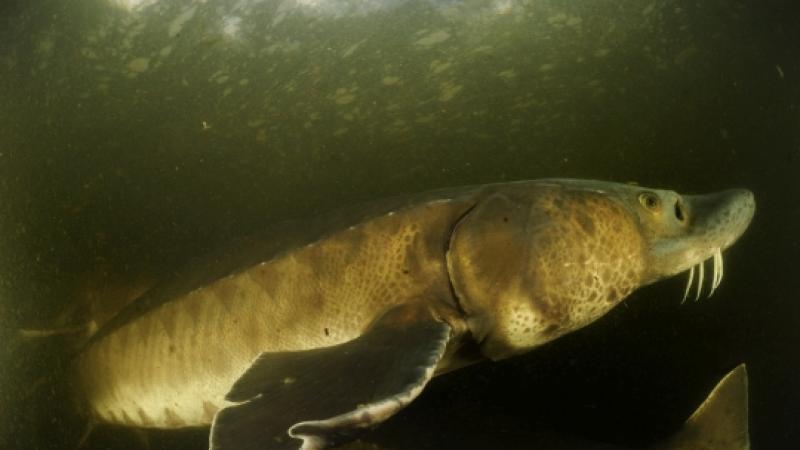
Bullfrog I Photo: Wikimedia Commons: https://commons.wikimedia.org/wiki/File:Bullfrog_-_natures_pics.
Freshwater is an essential resource for humans as well as nature. However, living organisms in rivers, lakes and wetlands are exposed to many human-made pressures. Climate change, overexploitation, changes and loss of habitats, pollution and the threat of invasive species are leading to a dramatic wildlife declines and losses. The 14 new recommendations for the global protection of freshwater biodiversity are based on current research knowledge and practical experience from European policy and administration.
These recommendations come at a time when two important international frameworks on biodiversity are being prepared: the Convention on Biological Diversity (CBD) and the European Union (EU) Biodiversity Strategy.
"This is an important moment to bring scientific knowledge into the process. Political strategies and decisions must emphasize the unique ecology of freshwater life and the many threats to it. In previous regulations, the protection of freshwaters has often been treated in an inferior manner. Inland waters have been included within land regulations – because they are not marine – or with seas and oceans – because they are aquatic. It is time that freshwater biodiversity is recognized in its own right - the latest Living Planet Report shows that the loss of freshwater populations is the most dramatic - a loss of 84 percent between 1970 and 2016," stresses IGB researcher Sonja Jähnig, who lead the study.
Recognising inland waters as a true ecological “third realm”
In their very first recommendation, therefore, the authors argue that freshwaters be considered as a separate, ecological "third realm" alongside land and sea, with special management requirements in future biodiversity agreements. For example, specific targets for freshwater ecosystems could be included in the existing Sustainable Development Goals (SDGs) 6 (Clean water and sanitation), 13 (Climate action), 14 (Life below water) and 15 (Life on land).
The Convention on Biological Diversity (CBD), adopted in 1993, also combines inland waters with terrestrial areas. The CBD Strategic Plan for Biodiversity 2011-2020 included 20 Aichi biodiversity targets. The most important targets related to freshwater ecosystems include: target 5 (Habitat loss halved or reduced), target 8 (Pollution reduced); target 9 (Invasive alien species prevented and controlled); target 11 (Protected areas increased and improved), target 12 (Extinction prevented).
Appropriate freshwater habitat targets should also be set within existing networks of protected areas, such as the European Natura 2000 network, which aims to protect core breeding and resting sites for rare and threatened species, and some rare natural habitat types.
Furthermore, many important freshwater habitats are overlooked, such as urban and agricultural water bodies. The separate designation of heavily modified water bodies (HMWBs) in the European Water Framework Directive (EU WFD) is a good example of how artificial or heavily human-influenced habitats could also be taken into account.
"Even if results of international conservation efforts have been very sobering so far – we scientists will continue to contribute our expertise to highlight the dramatic loss of freshwater biodiversity and help to mitigate and stop it. The recommendations formulated can help to improve the political framework for the protection of aquatic biodiversity," emphasises Sonja Jähnig.
This is what the researchers recommend to policy and administration actors
Recognise that:
- Freshwater should be considered a true ecological “third realm” that deserves legal and scientific prominence in future frameworks and strategies.
- Freshwater ecosystems should be viewed and recognized as life-supporting units that provide vital ecosystem functions and services in addition to their intrinsic value.
- Connectivity across multiple spatiotemporal scales and hydrological dimensions is a vital part of conserving and managing freshwater ecosystems.
- Freshwater ecosystems should be managed and delineated at the catchment scale, considering their drainage networks, catchment areas, and bordering ecotones.
- Global conservation strategies should make use of systems-thinking to properly navigate the strong societal and economic importance of freshwaters.
Improve monitoring and management:
- Restoration, improved management, and enforcement within existing freshwater protected areas could provide simultaneous climate and conservation benefits.
- The identification and adoption of flagship umbrella species is a valuable step for increasing recognition and prioritization of the freshwater biodiversity crisis.
- Improve the global evidence base for IAS impacts and the selection of IAS indicators of freshwater habitat status.
- Freshwater monitoring programmes should be reviewed, better coordinated, and funded at national and global scales.
- Hydrological and biological data on inland waters should be managed according to the FAIR principles (findable, accessible, interoperable, and reusable) to support data mobilization and access.
- Future biodiversity monitoring schemes should take advantage of novel research methods and data sources.
- Future policies should encourage strategic planning in catchment management to balance human and wildlife water needs.
Cross-cutting issues and approaches:
- National- and local-scale biodiversity strategies pertaining to freshwater species listing and protection should be better informed by global assessments.
- Future policies should support research and management that enhance the interactions between IWRM and ecological integrity for freshwater biodiversity conservation.
Read the article open access in Conservation Letters >
This study was initiated at the ALTER-Net conference in Ghent in June 2019. ALTER-Net is Europe's ecosystem research network.









